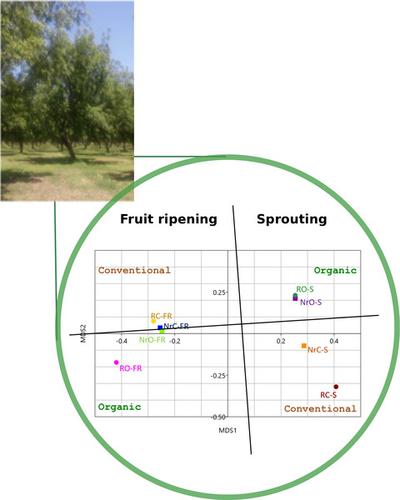当前位置:
X-MOL 学术
›
Lett. Appl. Microbiol.
›
论文详情
Our official English website, www.x-mol.net, welcomes your feedback! (Note: you will need to create a separate account there.)
Effect of organic and conventional farming on soil bacterial diversity of pecan tree ( Carya illinoensis K. Kosh) orchard across two phenological stages
Letters in Applied Microbiology ( IF 2.4 ) Pub Date : 2021-02-02 , DOI: 10.1111/lam.13452 L.E. Palma‐Cano 1 , H.A. Piñon‐Castillo 2 , S.H. Tarango‐Rivero 3 , A. Carbon 4 , J. Salas‐Leiva 1, 5 , L.N. Muñoz‐Castellanos 2 , C. Cravo‐Laureau 4 , R. Duran 4 , E. Orrantia‐Borunda 1
Letters in Applied Microbiology ( IF 2.4 ) Pub Date : 2021-02-02 , DOI: 10.1111/lam.13452 L.E. Palma‐Cano 1 , H.A. Piñon‐Castillo 2 , S.H. Tarango‐Rivero 3 , A. Carbon 4 , J. Salas‐Leiva 1, 5 , L.N. Muñoz‐Castellanos 2 , C. Cravo‐Laureau 4 , R. Duran 4 , E. Orrantia‐Borunda 1
Affiliation

|
We described the bacterial diversity of walnut grove soils under organic and conventional farming. The bacterial communities of rhizospheric and non-rhizospheric soils of pecan tree (Carya illinoensis K. Koch) were compared considering two phenological stages (sprouting and ripening). Sixteen OTUs were identified significantly more abundant according to the plant development, only one according to the farming condition, and none according to the soil origin. The OTUs specificaly abundant according to plant development included Actinobateria (2) and Betaproteobacteria (1) related OTUs more abundant at the sprouting stage, while at the fruit ripening stage the more abundant OTUs were related to Actinobacteria (6), Alphaproteobacteria (6), and unclassified Bacteria (1). The Gaiellaceae OTU18 (Actinobacteria) was more abundant under conventional farming. Thus, our study revealed that the plant development stage was the main factor shaping the bacterial community structure, while less influence was noticed for the farming condition. The bacterial communities exhibited specific metabolic capacities, a large range of carbon sources being used at the fruit ripening stage. The identified OTUs specifically more abundant represent indicators providing useful information on soil condition, potential tools for the management of soil bacterial communities.
中文翻译:

有机和常规耕作对两个物候阶段山核桃树(Carya illinoensis K. Kosh)果园土壤细菌多样性的影响
我们描述了有机和常规耕作条件下核桃林土壤的细菌多样性。考虑到两个物候阶段(发芽和成熟),比较了山核桃(Carya illinoensis K. Koch)根际和非根际土壤的细菌群落。根据植物发育,鉴定出 16 种 OTU 的含量显着增加,仅根据耕作条件鉴定出 1 种,而根据土壤来源没有鉴定。根据植物发育特别丰富的 OTU 包括在发芽阶段更丰富的放线菌 (2) 和 Betaproteobacteria (1) 相关的 OTU,而在果实成熟阶段,更丰富的 OTU 与放线菌 (6)、Alphaproteobacteria (6)、和未分类的细菌 (1)。Gaiellaceae OTU18(放线菌)在常规耕作下更为丰富。因此,我们的研究表明,植物发育阶段是塑造细菌群落结构的主要因素,而对耕作条件的影响较小。细菌群落表现出特定的代谢能力,在果实成熟阶段使用大量碳源。确定的 OTU 特别是更丰富的代表指标,提供有关土壤状况的有用信息,是管理土壤细菌群落的潜在工具。在果实成熟阶段使用大量碳源。确定的 OTU 特别是更丰富的代表指标,提供有关土壤状况的有用信息,是管理土壤细菌群落的潜在工具。在果实成熟阶段使用大量碳源。确定的 OTU 特别是更丰富的代表指标,提供有关土壤状况的有用信息,是土壤细菌群落管理的潜在工具。
更新日期:2021-02-02
中文翻译:

有机和常规耕作对两个物候阶段山核桃树(Carya illinoensis K. Kosh)果园土壤细菌多样性的影响
我们描述了有机和常规耕作条件下核桃林土壤的细菌多样性。考虑到两个物候阶段(发芽和成熟),比较了山核桃(Carya illinoensis K. Koch)根际和非根际土壤的细菌群落。根据植物发育,鉴定出 16 种 OTU 的含量显着增加,仅根据耕作条件鉴定出 1 种,而根据土壤来源没有鉴定。根据植物发育特别丰富的 OTU 包括在发芽阶段更丰富的放线菌 (2) 和 Betaproteobacteria (1) 相关的 OTU,而在果实成熟阶段,更丰富的 OTU 与放线菌 (6)、Alphaproteobacteria (6)、和未分类的细菌 (1)。Gaiellaceae OTU18(放线菌)在常规耕作下更为丰富。因此,我们的研究表明,植物发育阶段是塑造细菌群落结构的主要因素,而对耕作条件的影响较小。细菌群落表现出特定的代谢能力,在果实成熟阶段使用大量碳源。确定的 OTU 特别是更丰富的代表指标,提供有关土壤状况的有用信息,是管理土壤细菌群落的潜在工具。在果实成熟阶段使用大量碳源。确定的 OTU 特别是更丰富的代表指标,提供有关土壤状况的有用信息,是管理土壤细菌群落的潜在工具。在果实成熟阶段使用大量碳源。确定的 OTU 特别是更丰富的代表指标,提供有关土壤状况的有用信息,是土壤细菌群落管理的潜在工具。


























 京公网安备 11010802027423号
京公网安备 11010802027423号